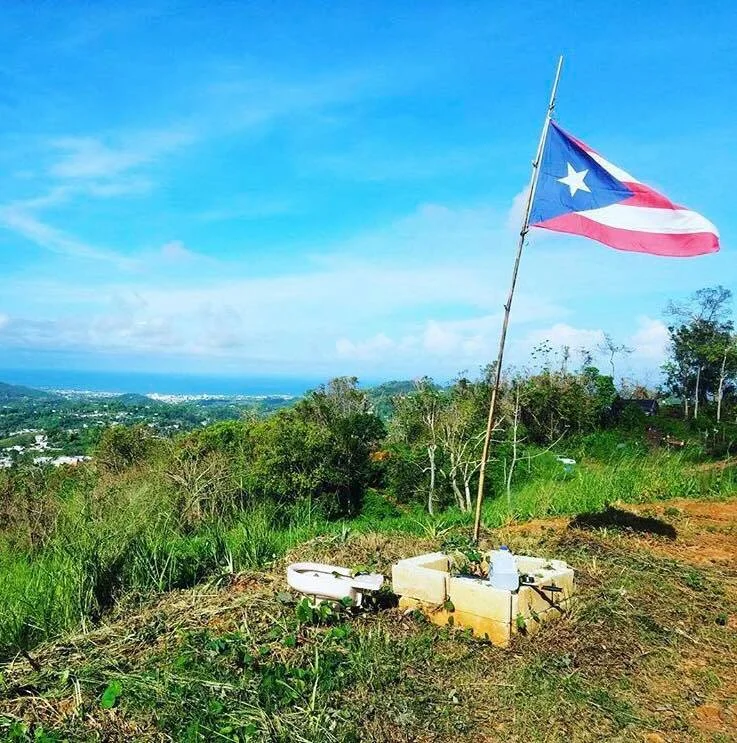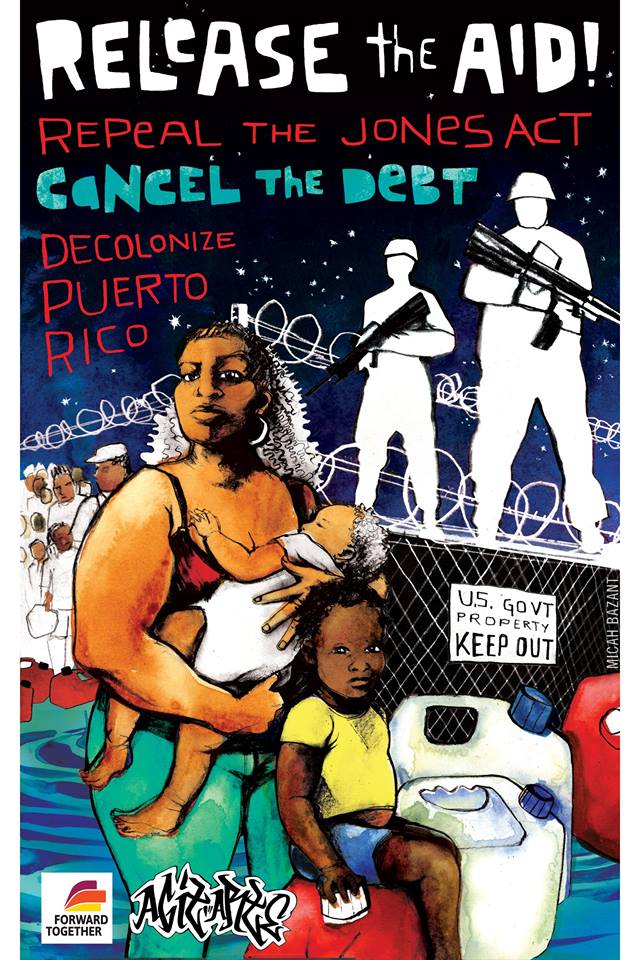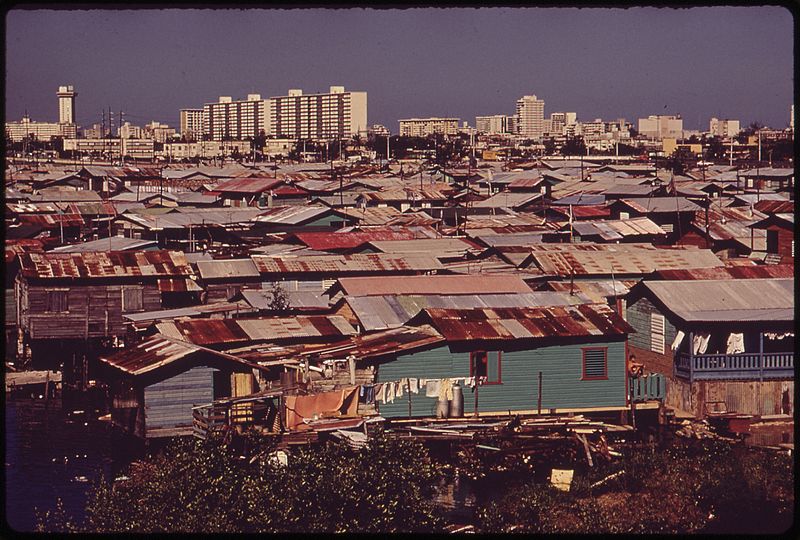La Marea Farm in Mayagüez. Photo: Ryan Hamilton
By ESENDOM October 24, 2017
We interviewed author and scholar Zaire Z. Dinzey-Flores on the humanitarian crisis facing the island of Puerto Rico following the aftermath of Hurricane María. Dinzey-Flores is an Associate Professor in the Department of Latino and Caribbean Studies at Rutgers University and author of Locked In, Locked Out: Gated Communities in a Puerto Rican City (University of Pennsylvania Press: 2013). She is also a contributor to the August 2017 issue of Latin America Research Review (LARR) on inequality and inclusion. Read her LARR article here. In this interview, Dinzey-Flores surveys the ongoing colonial relationship between the United States and Puerto Rico, illusory development, housing, gated communities, the importance of talking about local communities and the way forward for the people of Puerto Rico.
What are some of the factors that created the current humanitarian crisis in Puerto Rico?
The humanitarian crisis is a combination of a colonial and mercantilist system that is way past its expiration date, a finance-based economy and continued political corruption that resulted in an outsized debt, the decline in investments in infrastructure, people, and a social-safety net in favor of capital, and a perfect storm that cut through the middle of Puerto Rico. The abysmal response to the conflation of events--from the Federal government to the local government—have created the abyss that appears to have no end.
Can you talk about the state of Puerto Rico before Hurricane Maria hit?
Puerto Rico was and is mired in debt, with decaying infrastructure, politically stagnated in a colonial status, and I would specify a mercantilistic relationship that gave little room to attend to the impending social, economic, and environmental disasters. The thing with Puerto Rico is that it had the dressings of power and progress—big cities, smooth highways, a dollar economy, and proximity (literal and figuratively) to the United States. This is a mirage: a colonial one.
Image by AgitArte
I grew up in Puerto Rico, and my parents are Dominican immigrants. They have resided in Puerto Rico for 47 years, but I spent most of my life between the two islands. When we went from PR to DR back in the 1970s and 1980s it felt like traveling back in time. We went from showers in PR to warming up water on the stove and bathing with a “cubito” (cup) in DR. I remember sitting in movie theaters in Santo Domingo waiting for the power to come back up to finish the movie. Slowly, over 20 years, that time lapse between PR and DR closed. If you grow up like that, it’s a revelation that Cuba and likely DR could recuperate from such a blow much faster than a place like Puerto Rico could, which appeared to be so far-ahead among its Caribbean peers.
In some ways, references to Puerto Rico continue to carry an illusory idea of development. I also think that’s why it’s hard to comprehend the devastation; when there are images of people sporting modern clothes, driving cars in roads, going to a mall with air conditioning to charge their phones, it requires a mental leap for many to understand the grave humanitarian crisis that has hit the island. Because humanitarian crisis looks “backward,” with dirt roads and flimsy wooden shacks.
“In some ways, references to Puerto Rico continue to carry an illusory idea of development”
But an unregulated and unkept “developed” infrastructure is as vulnerable (and perhaps even more so) than one wooden shack. That’s why it was so damaging to take someone like 45 to Guaynabo and not to see, for example, a morgue or a hospital, or to get a sense of the vast loss of power and communication, or to go see a rural community, or even an urban community of informal housing, or drive through roads that were blocked, or that had fallen, or that full of potholes. There were so many scenes to see, so much to learn about how a crisis “looks” for a Caribbean island in the 21st Century.
Shanty towns in San Juan, Puerto Rico circa 1970s. Photo: Ken Heyman and John Vachon for the Environmental Protection Agency. Source: Wikipedia
What was the housing situation there?
Puerto Rico in the middle of the 20th Century was a laboratory for housing development. It received some of the largest U.S. Federal investments in housing construction, particularly public housing. The island was presented as a United Nations example to follow, for developing countries. A good portion of Puerto Rico’s economy depended on construction and a lot of this was in housing. But the stringent monitoring of housing construction in mid-century gave way to clientelism, corruption, lack of planning and zoning code enforcement, and building in flood-prone areas. It shocks me to see cement homes, buildings, roads, and bridges collapsing due to the hurricane. Certainly, some of that could have been prevented. Also, the economy and growing inequality has resulted in informal housing—largely constructed in areas that are prone to mudslides and flooding, and built with inadequate materials. These informal settlements, especially given their lack of social and economic access, are especially vulnerable.
What kind of political solutions will contribute to improve the lives of people in the island?
Certainly, the political-economic relationship needs to be addressed. But we must understand that this is not simply a political question, but an economic one and even more so a question of justice and survival. Repealing the Jones Act is essential. My fear is that a focus on sovereignty, however, could throw Puerto Rico into similar relationships to multilateral international institutions that would still recreate a surrogate colonial relationship with the U.S. That is true for the rest of the Caribbean, including Dominican Republic, Jamaica, USVI’s, Cuba, and all. The question of what self-determination looks like is centrally important.
Ordinary people in Puerto Rico are mobilizing to rebuild their lives. Mural painted by Zuleira Soto and members of the community in barrio Buena Vista, Mayagüez. Photo: Ryan Hamilton
If you can and are comfortable, would you mind commenting on the U.S. president’s response and reaction to Hurricane Maria in relation to Puerto Rico?
What can I say? As outrageous as his reactions have been, they are not completely surprising. It displays not only an inhumanity but more importantly a lack of knowledge, utter ignorance. I think it is not worth focusing so much on his reaction; and we should be figuring out how to find a way to address this supposed “debt,” which is a convenient label given to a century-old extraction of capital from the island.
Switching gears here, sort to speak, can you please explain the conclusion(s) you arrived at, upon conducting research for your first book, Locked In, Locked Out: Gated Communities in a Puerto Rican City (2013)—winner of the 2014 Robert E. Park Award from the American Sociological Association?
My book looks at the ways in which housing and neighborhood design and policy reproduce race and class inequality. I look at the policies and regulation that allow for privileged neighborhoods to be gated and public housing to be forced into gating, and how this informs social life and segregation. I found that indeed, race and class inequality are sustained spatially in Puerto Rico.
With the hurricane and the debt, I’ve kept wondering about these spatial inequities—regional as well as local. My book is about Ponce, and we’ve learned little about what’s happening in the island outside of the metro area; areas that remain largely incommunicado. Also, we’ve heard little about low-income communities across the island who are the most vulnerable to the disaster. We’ve heard nothing about public housing, the vast number of people who rely on public benefits. Those people who rely on an operable safety net are the ones that are most at risk. And this is as true after Hurricane María as before. There was a political-economic crisis before the storm and we hardly ever heard about local communities; and intellectuals are as guilty as anyone for the lack of focus on these communities. Perhaps it’s a function of the colonial situation being the preoccupation that is front and center. I’ve focused my work on ongoing experience of people; on how inequality persists; on how people live on account of the many social problems that confront the island. After the Hurricane, the trend continues as most conversations revolve around the colonial relationship. We have to talk about local people and their lives and take stock about how local dynamics may also drive those conditions. Poverty and inequality are problems always; I can only begin to imagine their impact on people during this type of crisis.
“There was a political-economic crisis before the storm and we hardly ever heard about local communities; and intellectuals are as guilty as anyone for the lack of focus on these communities.”
Did Locked In, Locked Out, change your perception of Puerto Rico and its people? What insights did you gain/acquire?
As I describe in my book, there is an intimacy that I brought to my research that made my relationship to the idea of “discovery” very different. One of the chapters I wrote—on gardens—was completely unexpected. What the book did was reveal the many ways in which the home and neighborhood spaces we inhabit are used and deployed to sustain race and class distinctions and inequities. But the book did not really change my perception of Puerto Rico and its people. It mostly showed me that people get very creative in supporting inequality, and that they do it in seemingly imperceptible ways.
In your book, you discuss two interrelated methods of gated communities: the first is the method in which middle-class and upper-class residents deliberately gate themselves in via private security guards and the building of walls and gates; the second—perhaps a more pervasive—method is one where the State intentionally gates—or “traps in”—working-class or society’s least desirables by surrounding them with gates and fences and controlling access to these public spaces. Can you please provide us with a succinct discussion of this matter for those readers who have yet to pick up your book?
Most people think gated communities are those neighborhoods where the rich put up a guard or have an electronic gate. These gates are seen as only operating in service of those who reside there. What I try to explain in the book is that there are multiple “gates,” varied functions of the gates, and that they are pervasive and are often erected for or against low-income communities of color. These gates may not necessarily be physical or obvious (as they are in the ones in the book), but they may still exist structurally--in regulations, in policies, and in practices. The gates are paramount in sorting, segregating, and keeping inequality. In the neighborhoods I study, public housing residents spoke of being locked in by the gates, while the privileged spoke about who was being locked out. Gates look both in and out and operate with varying but complementary logics. This ultimately informs opportunities and access.
What is your next research project?
I have a number of projects going on. I am working on a book that looks at real estate practices in a “Latino” and a “Black” neighborhood in Brooklyn to understand how built environments and space are manipulated to justify increasing property values. I am especially interested in how race is manipulated in those formulations. I am also working on a book on planning in Puerto Rico and the international reaches of those programs in Puerto Rico. This project may end up changing with Maria, as I contemplate how those planning practices that I have researched have then resulted in the current disaster.
I had planned to write the real estate book first, followed by the Puerto Rico planning book. That may change, as I figure out how to become actively involved in the rebuilding of a 2.0 Puerto Rico. My aspiration has always been to do more than research, to be engaged in policy and applied research, which is why I have urban planning and policy degrees in addition to the sociology degree. Last year, I became a board member of the New York City Housing Authority (NYCHA) and that has been rewarding and a way to reach beyond the research and the writing to the lives of people. Going forward, I’m trying to keep that commitment to myself.
___
Related:
How to Help Puerto Rico & the Caribbean with Hurricane Maria Aftermath





